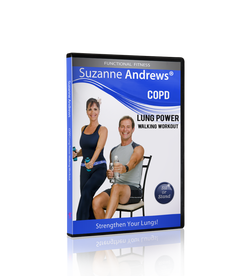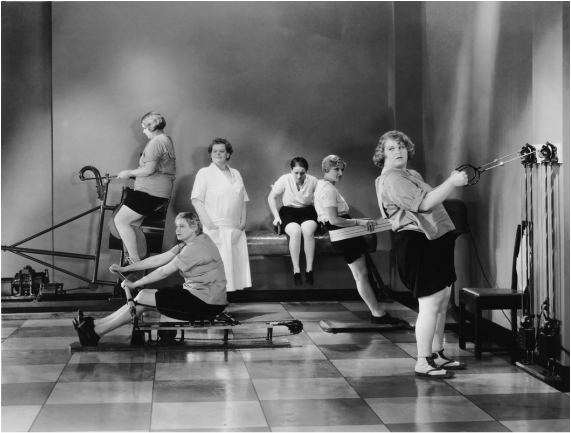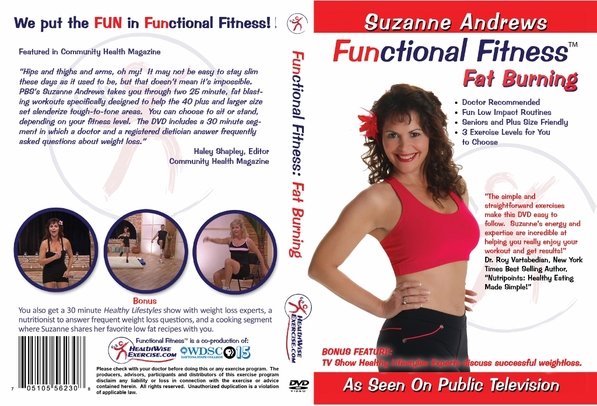|
www.healthwiseexercise.com/shop-fitness-dvdsWhen I was born, there were no dishwashers, no microwaves, no color TV, but my mom did have five remote controls. She even named them. They were Cindy, Lilly, Peter, Paul and myself, Suzanne. And lucky for me there were no birth control pills because I'm the result of two Catholics practicing the rhythm method!
Having modern conveniences today has made our lives easier, but at what cost? We burn 10,000 less calories a month now compared to 1970. We have so many gadgets to save time on doing the dishes, vacuuming, writing letters, remember having to write by hand? With todays technology, you'd think we'd have more time, yet the number one excuse for not working out is, "I don't have the time." Our good intentions get taken over by hectic work schedules and family demands. We ladies were raised to live life for everyone else - often at the sacrifice of our own health. I speak from experience because I used to carry around an extra 60 pounds of weight on my body. The simple act of walking was a struggle. Did you know that walking places a force of three times your body weight on the critical joints of your body? Being just ten pounds overweight places thirty pounds of pressure on your joints. So if you have knee, pain back pain, or the excruciating hip pain I had; lose the weight and you may very likely lose the pain. The good old days may well be ahead! Visit me at http://healthwiseexercise.com  Given that people with COPD have difficulty breathing, it seems almost cruel to suggest exercise. However, because the respiratory system is under attack, it's even more important for it to be functioning as well as possible. The muscles must be exercised regularly, lest they atrophy (shrink) and lose their strength. Then the body would be not only air-deprived, but physically weak too. Muscles need oxygen to grow, remain healthy and function efficiently, including your breathing muscles. Few would argue that walking is an excellent addition to your Healthwise Exercise program and with careful planning, you can benefit from a walking program. Before you begin, ask your doctor if it is advisable. Ask for recommendations and whether you need to adjust your oxygen use. Learn to use a pulse oximeter, which measures your oxygen levels – making sure to keep your o2 at 90 or above. Buy a nice pair of comfortable walking shoes. There are many models designed specifically for walking, to maximize the benefit and minimize the effort. Get the right size shoes. Too-tight shoes will restrict blood flow to the feet. Too-loose shoes will cause blistering. Buy some lightweight, breathable walking clothing and hit the pavement, literally, not figuratively. As you walk, maintain proper posture, remaining upright, rolling off the heel. Don't lean forward or arch backward. Walking with incorrect posture will injure your back and restrict your most important breathing muscles – your diaphragm. Your strides should be easy and slow initially. After you warm up, increase the length and speed of your steps. Inhale through your nose and exhale slowly through your mouth, with your lips shaped into an O. Your exhale should last twice as long as your inhale. Count your paces, breathing in for 2 steps and breathing out for 4. If you get winded or tired, stop and take some deep breaths. Monitor your heart rate and oxygen level and don't overdo it. Start with short walks and build up your tolerance level. This will strengthen and bolster your cardiopulmonary system. Try to walk daily. When the weather doesn't cooperate, take your workout indoors. Shopping malls and recreation centers have walking clubs. Make some friends and walk together. While COPD may require extra preparation, the benefits derived from walking are worth the effort. The air is still free, so help yourself to all you can. See other side for your bonus exercises. Please choose weight amount according to your tolerance. Begin with light weights and gradually increase. Please check with your doctor before beginning this or any exercise program. The COPD DVD can be purchased at www.healthwiseexercise.com 5 Eating Triggers You Need to Know Before You Diet
Many people find weight loss a daunting challenge and struggle to shed pounds and return to a healthy lifestyle. From yo-yo dieting to unrealistic goals and deprivation, people who struggle to lose weight often face an uphill battle. By identifying the triggers that lead to overeating and overcoming them, you will be well on your way to successful weight loss. 1.) Stress People have to deal with stressful situations every day. From hectic work schedules to strained family life and the pressures of the daily grind, stress can wear out even the strongest person. Some who struggle with weight loss use food as a way to ease the stresses in their life. This leads to weight gain, which leads to more stress, creating a vicious cycle that is difficult to break. 2.) Culture One of the main obstacles to people trying to lose weight is pressure from family. It can be very difficult to eat healthy meals when the family members are snacking on high fat and diet busting high calorie foods. In some cultures, it is a badge of honor to be overweight. Family gatherings such as holidays and celebrations may also lead to the pressure to overeat. 3.) Time of Day Does the clock dictate what goes on your plate? Many people eat not because they're hungry, but because they are accustomed to eating at a certain time every day. Others fail to listen to their body's cues and allow social pressures to dictate what they eat. Joining the co-workers for lunch is often an automatic behavior that has nothing to do with hunger. 4.) Place Studies have shown that where you eat has a huge bearing on how much we eat. When you sit down at a table to eat a meal you tend to eat less than if you're sitting on the couch. Eating while doing other tasks such as working at a desk can lead to overeating and weight gain. When eating a meal or a snack, focus on eating only. Attempting to multi-task while eating can cause you to lose track of the amount you're eating and take in too many excess calories. 5.) Social Factors It can be hard to turn down the invitation to go out to dinner with friends every weekend. Eating is a social activity, and for some, cutting out eating meals in restaurants can be a difficult step. There are ways to enjoy social meals without wrecking your diet. Invite friends to "eat in" at your home and provide healthy choices as a substitute. According to the National Institutes of Health, meditation is an effective way to lose weight. Meditation can help to release the stressors that lead to overeating. Another effective way to fight the battle with fat is through the practice of yoga. Yoga teaches how to focus the body's energy inward to solve problems and refocus the mind. Engaging in regular yoga and meditation can help you tune into your body's cues and recognize the signals that cause you to overeat. Best Workouts for Seniors Functional Fitness Fat Burning Hips and thighs and arms, oh my! It may not be as easy to stay slim these days as it used to be, but that doesn’t mean it’s impossible. PBS’s Suzanne Andrews takes you though two 25- minute, fat blasting workouts specifically designed to help the 40–plus set slenderize tough-to-tone areas. You can choose to sit or stand, depending on your fitness and comfort level. The DVD includes a 30-minute segment in which a doctor and a registered dietician answer frequently asked questions about weight loss. Also plus size friendly. ($17.99, Learn More Now JuggleFit Juggle Your Way to Fitness (Beginner Level) Bored by traditional exercise? You might be surprised to learn that juggling is an aerobic workout. Juggling challenges the body and mind, lubricates the joints in the arms and shoulders, boosts brain power, and helps with coordination and balance. This DVD, led by instructor Heather Wolf, includes nylon scarves, a balance and coordination workout with three levels of difficulty, a beach warm-up and cool-down, and practice tips to help you master the circus art. ($19.99, http://www.jugglefit.com) T’ai Chi Chih Joy Thru Movement Simpler than tai chi but with the same benefits, T’ai Chi Chih was created in the 1970′s and consists of 19 movements and one pose. A University of Wisconsin-Lacrosse study found that older adults who practice T’ai Chi Chih for five weeks experience less stress and a greater sense of well being. “With the accumulation of chi through T’ai Chi Chih, permanent changes in the metabolism and the thinking process take place”, says creator Justin F. Stone, now in his 90′s. The DVD includes 45 minutes of instruction on the principles of the movements, followed by a 45-minute practice. ($32.95, http://www.gkpub.com) Homebody This routine is low-impact hybrid of dance, Pilates and yoga that gets you moving while strengthening your core, improving your posture and stretching your limbs. The music will propel you through the workout, which makes use of common household items like a can of beans, ketchup bottle, throw pillows and a chair. Led by fitness instructor Jillian Hessel, the DVD includes a dance warm up, a chair workout, a mat sequence, a rise to standing end segment and a bonus tutorial to help insure correct posture. ($12.95, http:// www.jillianhessel.com) Walking for Fitness Kit with Kathy Smith DVD It may not be the first thing that comes to mind when you think of exercise, but walking can help you burn calories, increse energy, manage stress, reduce the risk of heart attack and other diseases, lower body fat, and revitalize muscles. Fitness expert Kathy Smith takes walkers to the next level with this kit, which includes two 1.5 pound hand weights, a pedometer and the indoor walking DVD. The program is the equivalent of a two mile walk and is designed for all ages and abilities. ($19.99, http://www.rejuvenationrehab.com) |


 RSS Feed
RSS Feed
